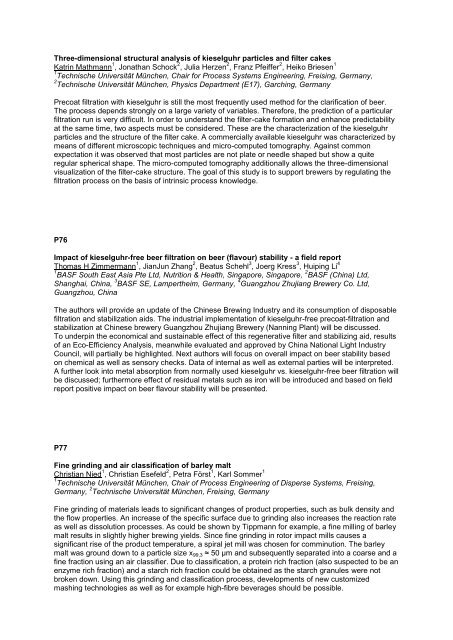here - the 34th European Brewery Convention
here - the 34th European Brewery Convention
here - the 34th European Brewery Convention
You also want an ePaper? Increase the reach of your titles
YUMPU automatically turns print PDFs into web optimized ePapers that Google loves.
Three-dimensional structural analysis of kieselguhr particles and filter cakes<br />
Katrin Mathmann 1 , Jonathan Schock 2 , Julia Herzen 2 , Franz Pfeiffer 2 , Heiko Briesen 1<br />
1 Technische Universität München, Chair for Process Systems Engineering, Freising, Germany,<br />
2 Technische Universität München, Physics Department (E17), Garching, Germany<br />
Precoat filtration with kieselguhr is still <strong>the</strong> most frequently used method for <strong>the</strong> clarification of beer.<br />
The process depends strongly on a large variety of variables. T<strong>here</strong>fore, <strong>the</strong> prediction of a particular<br />
filtration run is very difficult. In order to understand <strong>the</strong> filter-cake formation and enhance predictability<br />
at <strong>the</strong> same time, two aspects must be considered. These are <strong>the</strong> characterization of <strong>the</strong> kieselguhr<br />
particles and <strong>the</strong> structure of <strong>the</strong> filter cake. A commercially available kieselguhr was characterized by<br />
means of different microscopic techniques and micro-computed tomography. Against common<br />
expectation it was observed that most particles are not plate or needle shaped but show a quite<br />
regular spherical shape. The micro-computed tomography additionally allows <strong>the</strong> three-dimensional<br />
visualization of <strong>the</strong> filter-cake structure. The goal of this study is to support brewers by regulating <strong>the</strong><br />
filtration process on <strong>the</strong> basis of intrinsic process knowledge.<br />
P76<br />
Impact of kieselguhr-free beer filtration on beer (flavour) stability - a field report<br />
Thomas H Zimmermann 1 , JianJun Zhang 2 , Beatus Schehl 3 , Joerg Kress 3 , Huiping Li 4<br />
1 BASF South East Asia Pte Ltd, Nutrition & Health, Singapore, Singapore, 2 BASF (China) Ltd,<br />
Shanghai, China, 3 BASF SE, Lamper<strong>the</strong>im, Germany, 4 Guangzhou Zhujiang <strong>Brewery</strong> Co. Ltd,<br />
Guangzhou, China<br />
The authors will provide an update of <strong>the</strong> Chinese Brewing Industry and its consumption of disposable<br />
filtration and stabilization aids. The industrial implementation of kieselguhr-free precoat-filtration and<br />
stabilization at Chinese brewery Guangzhou Zhujiang <strong>Brewery</strong> (Nanning Plant) will be discussed.<br />
To underpin <strong>the</strong> economical and sustainable effect of this regenerative filter and stabilizing aid, results<br />
of an Eco-Efficiency Analysis, meanwhile evaluated and approved by China National Light Industry<br />
Council, will partially be highlighted. Next authors will focus on overall impact on beer stability based<br />
on chemical as well as sensory checks. Data of internal as well as external parties will be interpreted.<br />
A fur<strong>the</strong>r look into metal absorption from normally used kieselguhr vs. kieselguhr-free beer filtration will<br />
be discussed; fur<strong>the</strong>rmore effect of residual metals such as iron will be introduced and based on field<br />
report positive impact on beer flavour stability will be presented.<br />
P77<br />
Fine grinding and air classification of barley malt<br />
Christian Nied 1 , Christian Esefeld 2 , Petra Först 1 , Karl Sommer 1<br />
1 Technische Universität München, Chair of Process Engineering of Disperse Systems, Freising,<br />
Germany, 2 Technische Universität München, Freising, Germany<br />
Fine grinding of materials leads to significant changes of product properties, such as bulk density and<br />
<strong>the</strong> flow properties. An increase of <strong>the</strong> specific surface due to grinding also increases <strong>the</strong> reaction rate<br />
as well as dissolution processes. As could be shown by Tippmann for example, a fine milling of barley<br />
malt results in slightly higher brewing yields. Since fine grinding in rotor impact mills causes a<br />
significant rise of <strong>the</strong> product temperature, a spiral jet mill was chosen for comminution. The barley<br />
malt was ground down to a particle size x 99,3 ≈ 50 µm and subsequently separated into a coarse and a<br />
fine fraction using an air classifier. Due to classification, a protein rich fraction (also suspected to be an<br />
enzyme rich fraction) and a starch rich fraction could be obtained as <strong>the</strong> starch granules were not<br />
broken down. Using this grinding and classification process, developments of new customized<br />
mashing technologies as well as for example high-fibre beverages should be possible.





